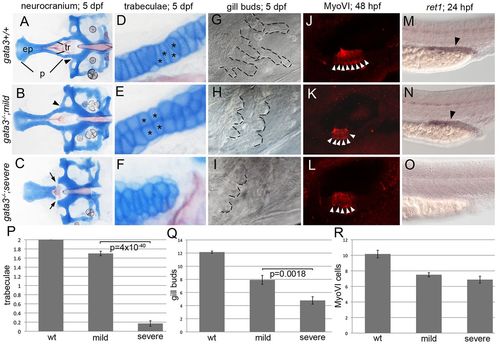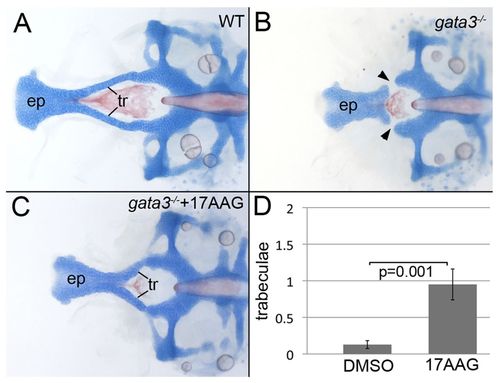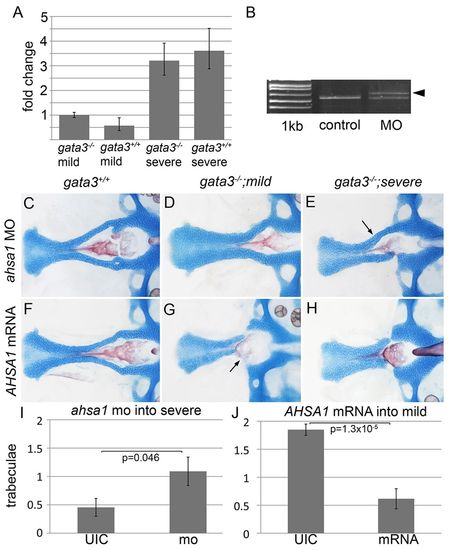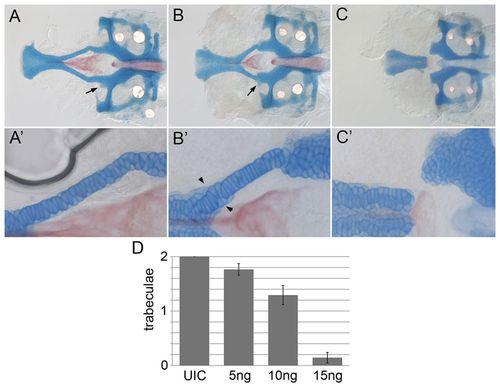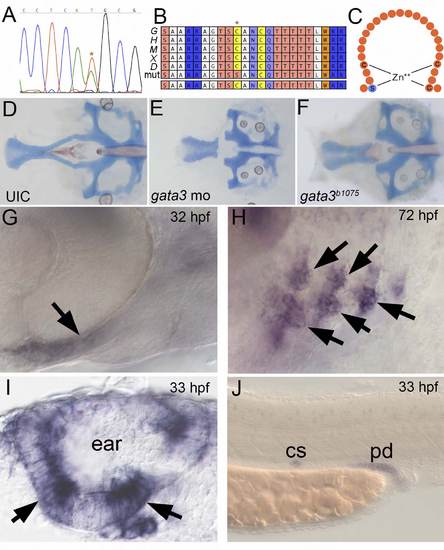- Title
-
Ahsa1 and Hsp90 activity confers more severe craniofacial phenotypes in a zebrafish model of hypoparathyroidism, sensorineural deafness and renal dysplasia (HDR)
- Authors
- Sheehan-Rooney, K., Swartz, M.E., Zhao, F., Liu, D., and Eberhart, J.K.
- Source
- Full text @ Dis. Model. Mech.
|
Genetic background influences the gata3 mutant phenotypes. (A–C) Flat-mounted neurocrania and (D–F) close-up views of the trabeculae (tr). In both (A) wild-type embryos and (B) mild gata3 mutants, the palate (p) is fully formed. However, there are rearrangements to the stacking of chondrocytes in mild mutants (asterisks D and E). (C,F) In severe mutants, the trabeculae are lost, generating a gap between the ethmoid plate (ep) and posterior neurocranium. (G–I) gata3 mutation disrupts outgrowth of gill buds (outlined). (H) Mild mutants generate fewer gill buds. (I) In severe mutants, the number of gill buds is further reduced. (J–L) Myosin-VI (MyoVI) labels sensory neurons (arrowheads) in the zebrafish ear. (K,L) Mild and severe mutants have fewer MyoVI -positive cells. (M–O) Wild-type and mutant embryos stained with the ret1 riboprobe. (M,N) ret1 expression is maintained in mild mutants (arrowheads). (O) In severe mutants, ret1 expression is absent. (P–R) Quantification of the defects in gata3 mutant embryos. All graphs show means ± 1 s.e.m. (P) The number of trabeculae per embryo are significantly reduced in severe mutants (average=0.17, s.e.m.=0.06, s.d.=0.46, n=58) compared with mild mutants (average=1.7, s.e.m.=0.05, s.d.=0.55, n=125). Wild-type embryos average=2 trabeculae (s.e.m.=0, s.d.=0, n=654). (Q) The number of gill buds per embryo is also significantly reduced in severe mutants (average=4.79, s.e.m.=0.57, s.d.=2.12, n=14) relative to mild mutants (average=7.92, s.e.m.=0.68, s.d.=2.35, n=12). Wild-type embryos average=12.15 gill buds (s.e.m.=0.17, s.d.=0.75, n=20). (R) Although there is a reduction compared with wild type (average=10.17, s.e.m.=0.49, s.d.=1.70, n=11), the number of MyoVI-positive cells are not significantly altered across mild (average=7.5, s.e.m.=0.27, s.d.=0.85, n=10) and severe (average=6.88, s.e.m.=0.44, s.d.=1.25, n=8) mutants. Anterior to the left; (A–F) dorsal views of flat-mounted neurocrania; (G–O) lateral views of whole-mounted embryos. |
|
Inhibition of Hsp90 partially restores trabeculae in severe mutants. (A) Zebrafish embryos were treated with levels of 17AAG that did not disrupt the craniofacial skeleton in wild type. (B) Untreated gata3 mutants in the severe background typically lack trabeculae (arrowheads). (C) Hsp90 inhibition partially restored the trabeculae, resulting in the fusion of the palate and posterior neurocranium. (D) 17AAG treatment of severe gata3 mutants significantly increases the number of trabeculae in treated embryos (average=0.95, s.e.m.=0.211, s.d.=0.94, n=20) compared with control, DMSO-treated, embryos (average=0.13, s.e.m.=0.05, s.d.=0.34, n=39). (A–C) Dorsal views of flat-mounted neurocrania, anterior to the left; ep, ethmoid plate; tr, trabeculae. PHENOTYPE:
|
|
Ahsa1 is necessary and sufficient to promote severe gata3 phenotypes. (A) ahsa1 expression is higher in gata3 mutants and wild-type embryos in the severe background. (B) The ahsa1 morpholino causes misplicing of ahsa1 mRNA [arrowhead in morpholino (MO) lane; 1 kb=1 kb plus ladder]. (C,D) In both wild-type and mild mutant embryos ahsa1 morpholino injection did not disrupt the trabeculae. (E) Knocking down ahsa1 in severe mutants resulted in a partial restoration of the trabeculae (arrow). (F) Wild-type embryos injected with low levels of AHSA1 mRNA display no craniofacial defects. (G,H) Under these conditions, mutants from the (G) mild background closely resemble those from the (H) severe background, with trabeculae loss (arrows). (I) Ahsa1 loss-of-function significantly increases the number of trabeculae in severe gata3 mutants (average=1.09, s.e.m.=0.25, s.d.=0.83, n=11), relative to uninjected control mutants (average=0.455, s.e.m.=0.16, s.d.=0.52, n=11). (J) Injection of AHSA1 mRNA significantly reduces the number of trabeculae in mild gata3 mutants (average=0.615, s.e.m.=0.18, s.d.=0.37, n=13), relative to uninjected mutants (average=1.85, s.e.m.=0.1, s.d.=0.65, n=25). (C–H) Flat-mount images; anterior to the left. |
|
Graded injection of gata3 morpholino recapitulates the background-specific gata3 mutant phenotypes. (A,A2) Uninjected (UIC) embryos have normal neurocrania and trabeculae. (B,B2) Injection of 5 ng gata3 morpholino results in the lateral commissure attaching to the trabeculae (arrow, B) and improper stacking of cells within the trabeculae (arrowheads, B2). (C,C2) Injection of 15 ng of gata3 morpholino causes trabeculae loss. (D) Quantification of the average number of trabeculae/embryo. PHENOTYPE:
|
|
Identification of a gata3 mutant zebrafish and expression of gata3. (A) The b1075 allele has a T>A point mutation (asterisk) in the 28th bp of the fourth exon of gata3. The chromatograph shows a heterozygote. (B) The mutation generates a predicted C>S missense mutation in the conserved 2nd Zinc Finger domain of Gata3 (G, Gallus gallus; H, Homo Sapien; M, Mus musculus; X, Xenopus laevis; D, Danio rerio, mut, b1075). (C) Schematic representation of the affected amino acid. (D-F) Embryos (E) injected with gata3 morpholino phenocopy (F) b1075 mutants. (G-J) Tissues disrupted in HDR express gata3. (G) Maxillary neural crest cells express gata3 (arrow). (H) Forming gill buds express gata3 by 72 hpf (arrows). (I) At 33 hpf, gata3 is expressed strongly in regions of the ear that will generate sensory cells (arrows). (J) Both the pronephric duct (pd) and Corpuscle of Stannius (cs) express gata3 at 33 hpf. Lateral views, anterior to the left. UIC=uninjected control. EXPRESSION / LABELING:
PHENOTYPE:
|

